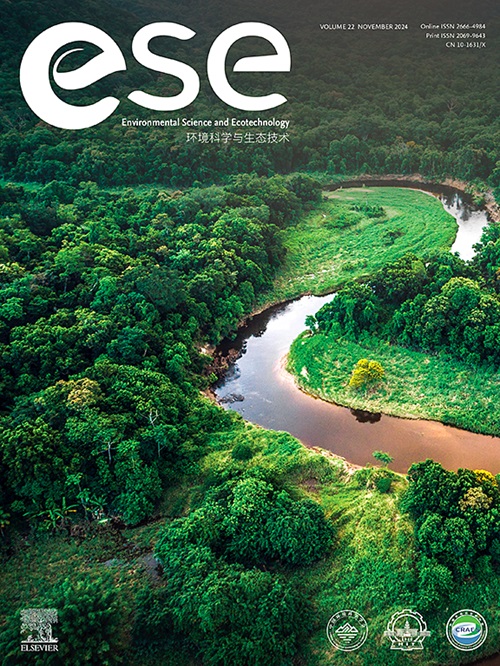机器学习揭示了由土壤侵蚀类型驱动的不同水生有机物模式
IF 14.3
1区 环境科学与生态学
Q1 ENVIRONMENTAL SCIENCES
引用次数: 0
摘要
显色性溶解有机物(CDOM)具有独特的光学性质,是了解全球碳循环中水生有机物动态的重要指标。土壤侵蚀是湖泊吸收CDOM的主要来源,它将陆源有机质输送到水体中,显著改变了CDOM的来源、生物有效性和分子复杂性。然而,不同土壤侵蚀区湖泊CDOM的空间格局尚不清楚。在这里,我们开发了一个强大的机器学习框架(rmsecaration = 0.87 m-1),通过整合1300多个原位水样和Landsat 8 OLI表面反射率数据来估计湖泊中的CDOM浓度。然后,我们将该模型应用于2020年面积大于0.1 km2的湖泊的CDOM空间分布图。冻融化侵蚀区、风蚀区和水力侵蚀区在355 nm处的平均CDOM吸收系数分别为3.73 m-1、6.31 m-1和3.72 m-1,反映了侵蚀强度的显著变化。两轴主成分分析解释了不同土壤侵蚀类型下超过48%的CDOM变化。化学表征表明,风蚀区和水蚀区以多环芳香族化合物为主,冻融侵蚀区则以多肽和不饱和脂肪化合物为主。该研究强调了陆地土壤侵蚀过程与水生DOM组成之间的重要联系,为评估内陆生态系统的全球碳循环和碳储存提供了重要见解。本文章由计算机程序翻译,如有差异,请以英文原文为准。

Machine learning reveals distinct aquatic organic matter patterns driven by soil erosion types
Chromophoric dissolved organic matter (CDOM), characterized by unique optical properties, is an essential indicator for understanding aquatic organic matter dynamics within global carbon cycles. Soil erosion, a major source of CDOM received by lakes, transports terrestrial organic matter to water bodies, altering sources, bioavailability and molecular complexity of CDOM significantly. Yet, the spatial patterns of CDOM in lakes from different soil erosion regions are still unknown. Here, we developed a robust machine learning framework (RMSEcalibration = 0.87 m-1) to estimate CDOM concentrations in lakes by integrating over 1300 in situ water samples with Landsat 8 OLI surface reflectance data. We then applied this model to map the spatial distribution of CDOM across lakes larger than 0.1 km2 in 2020. Our analysis revealed distinct spatial patterns, with mean CDOM absorption coefficients at 355 nm of 3.73 m-1 in freeze-thaw erosion regions, 6.31 m-1 in wind erosion regions, and 3.72 m-1 in hydraulic erosion regions, reflecting significant variations driven by erosion intensity. Two axes of PCA analysis explained over 48 % variations of CDOM for different soil erosion types. Chemical characterization indicated that polycyclic aromatic predominated in wind and hydraulic erosion regions, whereas freeze-thaw erosion regions exhibited higher proportions of peptides and unsaturated aliphatic compounds. This study highlights the crucial connection between terrestrial soil erosion processes and aquatic DOM composition, providing vital insights for evaluating global carbon cycling and carbon storage within inland ecosystems.
求助全文
通过发布文献求助,成功后即可免费获取论文全文。
去求助
来源期刊

Environmental Science and Ecotechnology
Multiple-
CiteScore
20.40
自引率
6.30%
发文量
11
审稿时长
18 days
期刊介绍:
Environmental Science & Ecotechnology (ESE) is an international, open-access journal publishing original research in environmental science, engineering, ecotechnology, and related fields. Authors publishing in ESE can immediately, permanently, and freely share their work. They have license options and retain copyright. Published by Elsevier, ESE is co-organized by the Chinese Society for Environmental Sciences, Harbin Institute of Technology, and the Chinese Research Academy of Environmental Sciences, under the supervision of the China Association for Science and Technology.
 求助内容:
求助内容: 应助结果提醒方式:
应助结果提醒方式:


